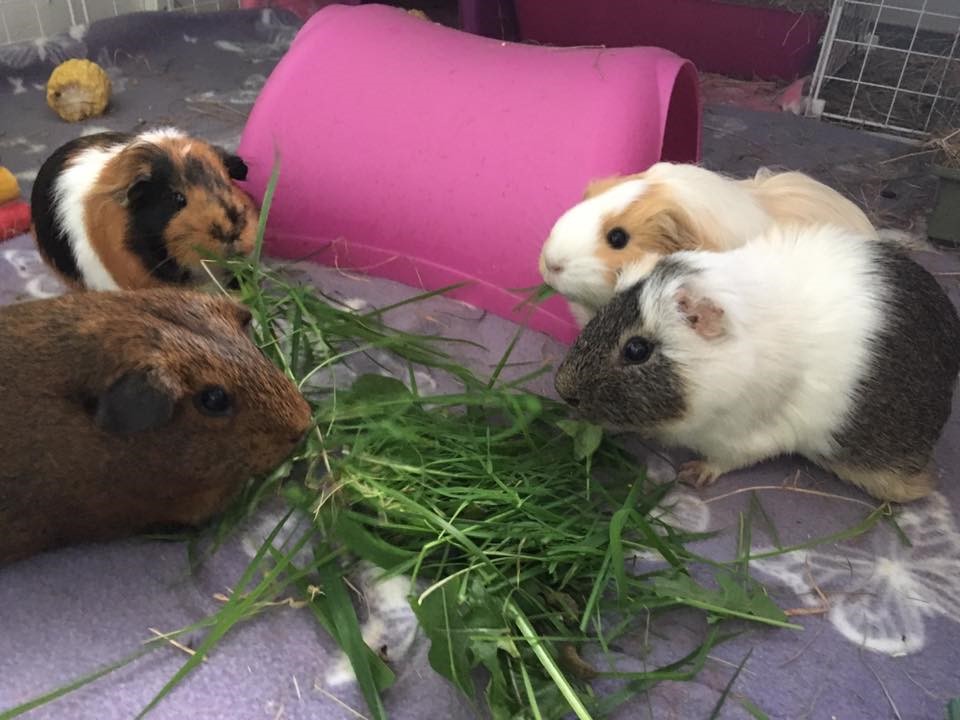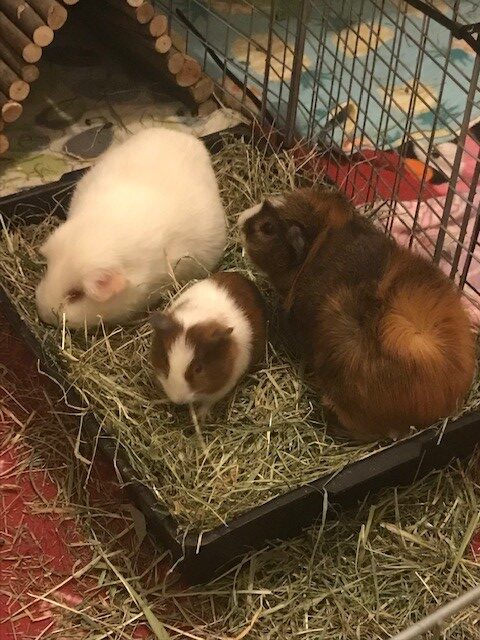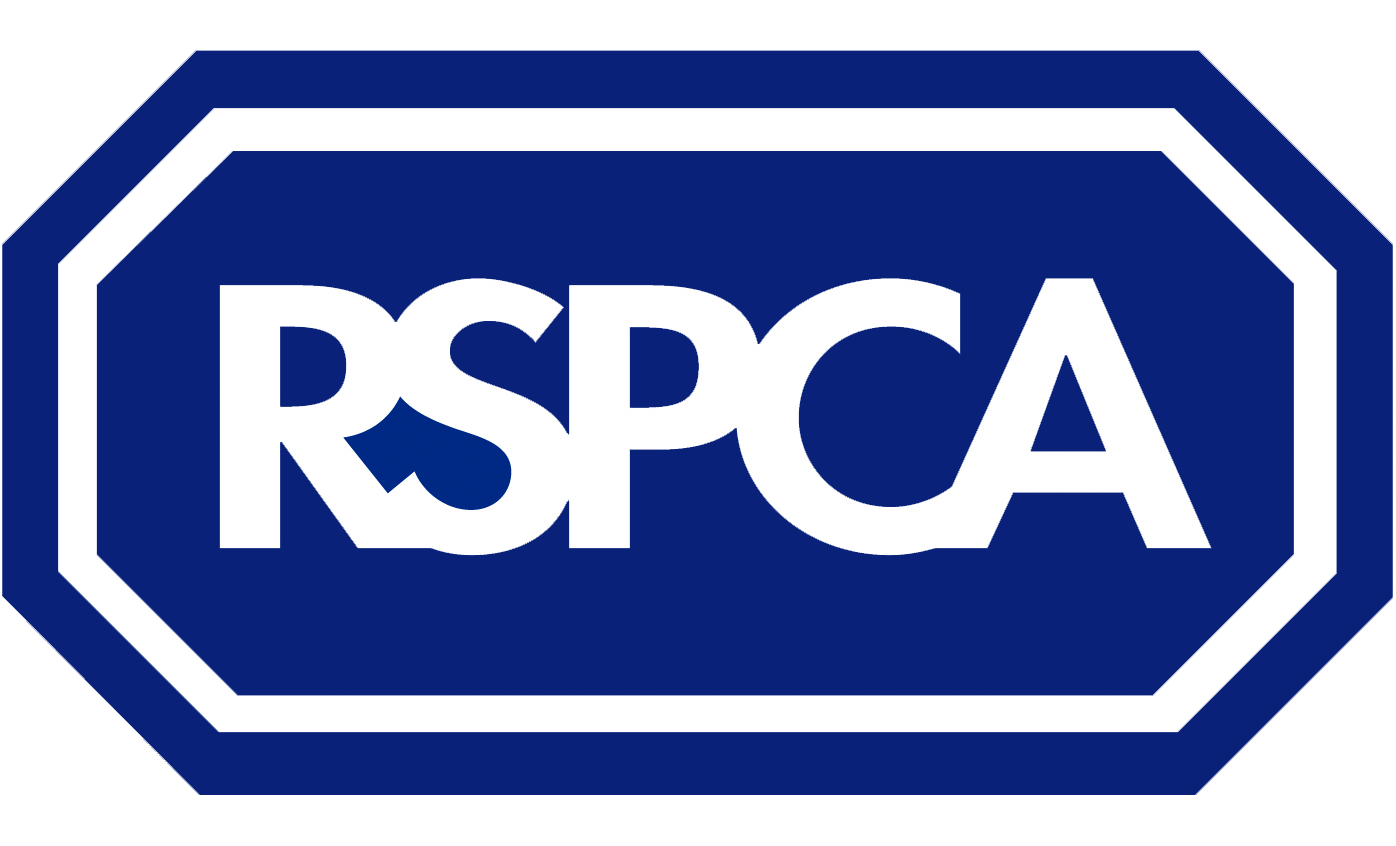Guinea pigs are naturally gregarious creatures who love to eat, chat and doze with each other!
Today’s blog is quite a long one! Over the years I’ve bonded many guinea pigs of all ages and temperaments. So here’s my comprehensive guide which you might find helpful. It’s important to say that all piggies have different personalities – not all introductions work out, not all personalities will match, some bonds will be instant others might take weeks or months. My techniques might not work for everyone but I would strongly suggest that gradual introductions are the best.

Getting Started
Choosing a match
Guinea pigs can live happily in various combinations such as:
- Two or more females
- One neutered male with one or more females
- Two males
It is possible for more than two males to live together (particularly if they are siblings and have always lived together) however from our experience fallings out are more common in this combination. If you have a pair of males we’d recommend leaving them as a pair. If you have a single unneutered adult male, a young male (under the age of puberty) could be a good match. However, we’d normally recommend neutering and pairing with a female. Neutering a male does not change their personality or make them easier to bond with another male, it just stops them reproducing!
In my experience the easiest to introduce are youngsters, ideally babies at 6-8 weeks of age. They pose little threat to an existing guinea pig and are good at getting out of the way if chased! They also don’t tend to retaliate like adults can do. I’ve never had a ‘baby bond’ that didn’t work. If you want the easiest option, look to adopt a youngster. Once they hit puberty (usually 3-6 months) bonding usually gets harder!
Common sounds/behaviour when bonding (see behaviour blog for detail):
It is key to recognise what sounds mean and what their behaviour and body language is telling you. This will be important to stop any interactions escalating into a fight:
- Rumble-strutting
- Chattering
- Mounting
- Yawning
- Raising their heads together
These types of behaviour are all natural and generally not anything to worry about. However, when pig chattering gets very loud and they lean into their back legs (ready to lunge) this means a real fight is likely to happen. If you do need to separate the guinea pigs, do not put your hand in! Use a dustpan or something solid to break them apart. I tried to bond two adolescent boars then I was inexperienced, and I got a terrible bite that led to antibiotics and major swelling – it was not fun!
Week One – Living Side by Side
I recommend guinea pigs live side by side for one week during this stage. This will give the guinea pigs time to get used to each other’s smell and tolerate each other’s presence in a non-threatening way. Putting guinea pigs in the same area straight away is extremely stressful for both your guinea pig and their potential new friend. Don’t rush the process!
The set up
- Create a living space where the guinea pigs can live alongside one another 24/7 with nose to nose contact without being able to harm each other. If you use C&C cages this is very easy to do (as pictured above by adding grids to make a ‘barrier’ down the middle of your existing cage). If you have an alternative set up, you could place two runs or cages next to each other or place a divider within a room to create a space on each side which allows them contact.
- Make sure you provide each side with a water bottle, litter trays, hidey huts and toys as usual.
- During this time try to keep to a routine that your existing guinea pig is used to (feeding or handling at the same time as usual). This will reduce the stress in an already quite stressful situation.
- It’s very important that at this stage the guinea pigs remain in close contact 24/7 so they can get used to each other. If you are regularly removing either guinea pig from the situation, then it defeats the purpose of the exercise!
- If you have two separate cages they must be able to physically touch noses through the bars. If they can’t reach or are too far apart then this stage won’t be effective. They might not even notice each other’s presence!
- A final point to note is that often the space each guinea pig has at this stage is likely to be smaller than the final space they will be living in together when successfully bonded (particularly if you are dividing up an existing C&C cage). This is fine as a temporary measure.
What to look out for
At this point we largely need to leave the guinea pigs to settle and become accustomed to each other and their new surroundings. However, you should monitor their behaviour to give you a general idea of how they are initially getting on.
Common behaviours in bonding in stage one:
- One guinea pig ‘pacing’ at the divide, chewing at the bars and generally seeming like they are trying to break through to the other guinea pig. Particularly common with neutered males who are being bonded with females.
- Avoidance – sometimes it seems that the guinea pigs are not communicating at all and may keep away from each other. They may seem more interested in trying to pull veg or hay through the divide than meeting their new friend.
- Sniffing through bars – guinea pigs often try and get a cheeky sniff of a new guinea pig’s behind! This can be met with annoyance, aggression or indifference.
- Rumble-strutting & chattering –very common with neutered males being introduced to females. The females tend to watch… or sometimes they just walk away!
- Nipping – occasionally a guinea pig will try and nip a new arrival. Hopefully, no serious injury will occur due to the divide, but it’s important to keep an eye out for this. You can always add another layer of fence to stop mouths getting through!
Week Two – Introductions in a neutral space
The next stage can be slightly more nerve-wracking, so make sure you have plenty of time and if you feel nervous have a friend on hand for support! Initial introductions can be vocal, however most behaviour you will witness is completely natural and necessary for guinea pigs to begin to establish a bond. If the piggies are not getting on with the barrier in place don’t move on to this stage, allow further time side by side for things to settle.
The set up
- You will need a space that neither guinea pig has been in before, roughly 1-2 metre square. This could be in a hallway or in a safe, quiet space where you can place a pen/run for them to go in. If your guinea pigs live indoors but are used to going outside it may be suitable to put them on the lawn in a run. However, some guinea pigs aren’t used to being outdoors and ‘freeze’ and hide when outside or in a strange place so you’ll need to keep this in mind. A scared guinea pig will often not engage in the bonding process or attack out of fear.
- If you are placing the run on lino or a wooden floor, make sure you put down a rug or blanket. Guinea pigs can feel unsafe on slippery floors, especially if they aren’t used to it.
- Place a large pile of veggies in the centre of the pen, but cage ‘furniture’ with single entrance such as hidey huts at this stage. We don’t want either pig to be chased or cornered. Watch out for resource guarding and adjust set up accordingly.
- Make sure you can easily access either guinea pig if you need to remove them from the pen. Have a dustpan or some form of ‘divide’ handy in case you need to intervene if you think a fight is about to occur (see above for information on behaviours and sounds to look out for).

How to start
- We recommend starting when you have a weekend free to monitor. The first meeting could be over in anywhere between a few minutes to a few hours depending, on how they get on at this first meeting, so make sure you have plenty of time.
- Place both guinea pigs in the run/pen at the same time.
- Normally guinea pigs ignore each other and proceed to eat the veg provided in the centre. Once they are full they will then usually notice each other and this is when the fun begins!
- Monitor closely – at this stage chasing, rumble-strutting, mounting and chattering are to be expected. Try not to intervene unless particularly loud and persistent chattering occurs combined with head raising and close contact.
- Do not let behaviour escalate into a full fight – fights can be nasty and lead to injuries that may even need stitches. Furthermore, you could ruin any chance of a potential bond in future.
- If you believe the behaviour is becoming aggressive and may lead to a fight do not put your hand in to separate. Quickly take your dustpan (or other divide) place it between the guinea pigs and remove either guinea pig from the situation. Place both guinea pigs back in their cages (with divide in place) to calm down. They will be stressed and need at least a day to settle.
Positive signs
You may see all the behaviours already mentioned at some point but the aggressive behaviour should begin to settle if the initial bonding session goes well. However, please keep in mind that guinea pigs will need time to build trust with each other. At this stage we just want them to tolerate each other – their true relationship will develop later.

Positive signs include:
- Eating next to each other after the initial excitement of food has worn off.
- Walking around and past each other with no obvious interaction or at least no aggression (mounting and raising heads can be okay if not coupled with loud chatter).
- Quiet chattering to each other while sitting calmly in a relaxed posture (more gentle sign of annoyance).
- Mounting and chasing initially which lessens and which the guinea pig being chased either tolerates or doesn’t retaliate with outright aggression (head raising or a brief squeal is fine).
- They can meet nose to nose without loud chatter or other signs of aggression.
- Lying relaxed in the same pen but sitting separately (so long as they have definitely noticed and interacted with each other).
What next?
- If all is well we’d recommend keeping them together for a couple of hours. You can then separate and repeat the process on two or three more occasions over week 2 before committing to keeping them together permanently. Move on to week three guidance below!
- If you believe the guinea pigs are getting on well and you do not want to separate after this initial introduction you can choose to keep them together. However, they should ideally remain in the neutral space for 24-48 hours showing positive signs before you consider putting them into their new cage together. They will need to be closely monitored at this stage as this is when fights are most likely to occur. Make sure there is ample veg and hay available (scattered not in a bowl), two water bottles and no cage furniture which only has one exit (tunnels are fine). If all is well after 48 hours in a neutral territory skip to ‘Week 4 – Consolidating the bond’ below!
Week Three – Further introductions
At this point you will have had 2-3 supervised meetings in a neutral space and should be seeing lots of positive interaction such as eating, grooming themselves and generally being comfortable in each other’s presence. It’s likely you will still be seeing some chasing, rumble-strutting and mounting but this should be limited and not escalate into anything serious. You should now be ready to move on to week four!
Week Four – Consolidating the bond
Congratulations, you are nearly there! By week four most of the hard work should be done and you will be able to leave the guinea pigs to settle and develop their relationship. For the first few weeks all we want is for them to tolerate each other and be comfortable in each other’s company. Now we can work on them becoming closer and hopefully best buddies!
Please note, don’t worry if your guinea pigs don’t seem ‘close’ at first, it can take several weeks or even months for them to really develop a solid bond – much like us humans! But never fear, just having another piggy around is much better than them living alone, even if they aren’t best friends straight away.

Living together permanently
- Once you are happy that they are settled in a neutral space and can tolerate each other without becoming overly aggressive you can think about putting them in their new home.
- You should make sure that their shared housing is completely cleaned out so that no smells remain (particularly if your existing pig has lived in there previously). Throw away any cage furniture that retains scent but can’t be washed – for example; cardboard items and items made from organic materials such as wicker or hay. Plastic items such as hidey huts are fine but may need a good wash.
- Make sure that you have two of everything (or more if you have several pigs). For example, you need at least two litter trays or hay eating areas, two hidey huts, two water bottles. Ideally, for two guinea pigs we’d recommend four litter trays or hay eating areas to significantly reduce the likelihood of disagreements over resources. Furthermore, don’t use food bowls to feed veggies. Instead try ‘scatter feeding’. Scatter feeding is when you spread food out across their pen into all areas. It’s a much more natural way for guinea pigs to eat and reduces the close contact they would encounter when eating out of the same bowl.
- Only use cage furniture that has two exit points such as a wooden bridge, tunnel or a house with two doors. Guinea pigs can bully each other by blocking a hidey hut with a single exit, thereby causing stress because there is nowhere for the other pig to escape to. In a few weeks’ time when they are more settled you can reintroduce single-exit furniture if you wish.
- Add both guinea pigs to their new home at the same time. At first they will be more interested in their new surroundings than each other so keep a close eye when the novelty of their environment starts to wear off.
- Again, during this time we recommend that you keep a close eye on them (as in Week Two – Introductions in a neutral space) as some aggressive behaviours can return. Generally, if they are okay for 24-48 hours in their new home together then you have cracked it! Do not separate unless you see signs of severe aggression. For the most part they just need to settle and be left to it. It might be a good idea to check over each pig once a day for injuries.
- Now they are together, do not separate! For example, if one of your guinea pigs becomes ill always take them to the vet with their cage-mate (if you have several you can just take one as a friend if it’s not practical to take them all). Be warned; if you do take a single guinea pig from a group they may be seen as a ‘new arrival’ when returned and you may have to start the bonding process from scratch. It’s better to be safe than sorry, so always take a guinea pig buddy along to the vet. A ‘guinea pig friendly’ vet will be more than happy to have friends along for the ride!

Congratulations! You’ve made it to the end of this epic post! Tomorrow we’ll be rounding things off my looking at guinea pig health.
Hannah x




Comments are closed